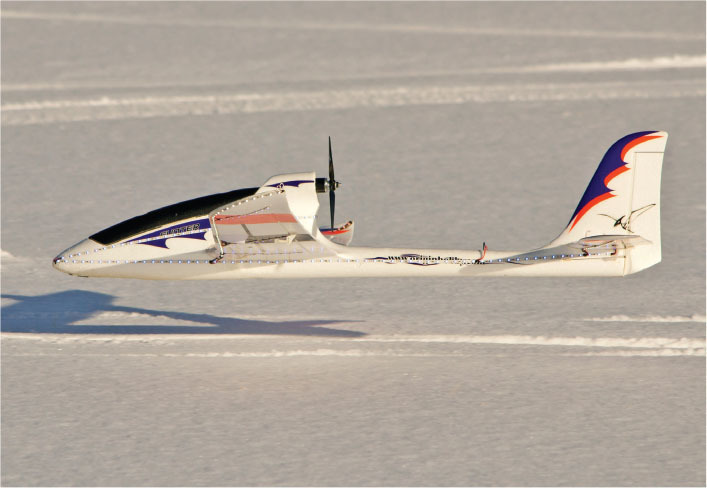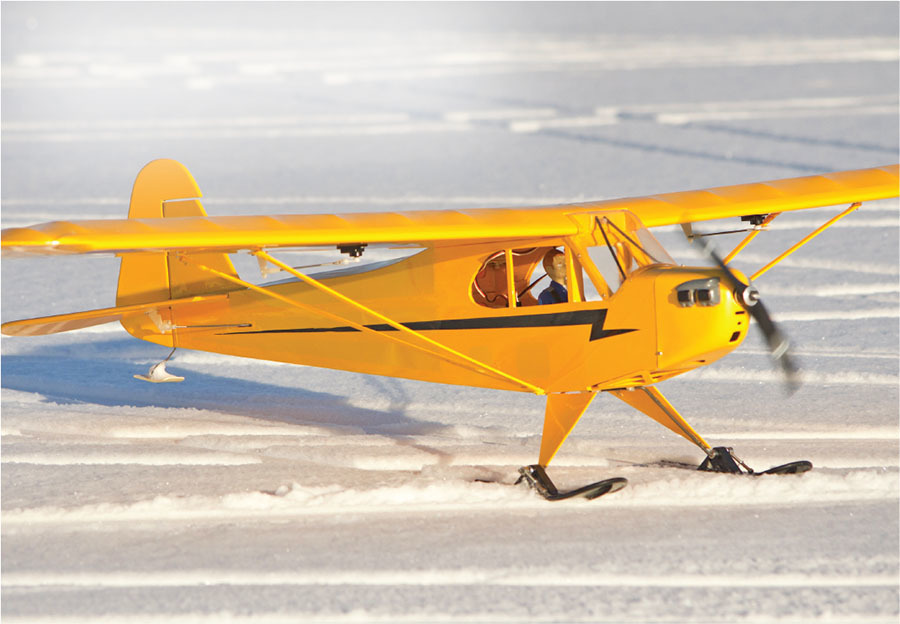Electrics
MANY OF YOU ARE already aware of what I am about to write: RC flying in the snow is a lot of fun! There is something really pleasing about carving tracks in a fresh blanket of snow as you perform touch-and-gos with your winged aircraft. All you need is a snow-capable model and a few simple precautions to mitigate the cold.
The joys of snowy runways are relatively new to me. Until a few years ago, I had always lived south of Interstate 40, where there’s not much snow. I am making up for lost time now that I live in Buffalo, New York. Many of the modelers here take great pride in flying year-round. I aspire to follow their example.
What to Fly
There is a variety of electric-powered, fixed-wing models that can operate from the snow. Some of them even seem to be custom-made for the white stuff. Floatplanes and seaplanes are prime examples. In a sense, flying off of the snow is still float-flying. The water is merely a bit colder! Most water-friendly models are also snow-friendly without making any modifications. The only obvious exception applies if your model has a protruding water rudder. It would be a good idea to remove it or tuck it away to prevent damaging it by dragging it through the snow. One of my favorite water-based models to fly in the winter is the Twin Pond Master. This two-motor variant of the venerable Puddle Master was designed to use Speed 400 brushed motors and NiCd batteries. Mine has been upgraded with brushless motors and LiPo battery power. It is a simple airplane that does many things well. I use differential thrust for yaw control on water, snow, and in the air. Because the fuselage has a wide, flat bottom, I can remove the detachable wing-mounted tip floats when I’m flying off of snow.

Numb Thumbs
Flying from the snow is not all fun and games. In fact, it can be downright miserable if you do not take steps to allay the effects of cold weather on you, the pilot. We all have different thresholds for comfort. The first step is to dress appropriately for the conditions. I have not yet found gloves that are thin enough to let me comfortably manipulate the sticks on my transmitter (I’m a pincher) and also keep my hands warm, so I wear standard winter gloves until just before I am ready to fly. Then I doff the hand gloves and utilize a transmitter glove. What is a transmitter glove? It is like a jacket that covers your hands and the transmitter while you fly. I have a transmitter glove made by Ace Wing Carrier (a gift from my friend, Sparky). I can’t imagine flying in winter without it.Don’t Nuke ‘Em
Most of the electronic gear in our electric-powered RC models will operate fine in freezing conditions. One glaring exception is the batteries. They can become very anemic in the cold—especially LiPo cells. I have a simple strategy for keeping batteries warm on cold days. First of all, I am a minimalist when it comes to packing for snowy flights. I typically bring only a transmitter and a few charged flight batteries. I have no desire to charge batteries or fix things in freezing conditions, so why bring extra stuff? But I digress. The transmitter and batteries easily fit inside a double transmitter case. Just before I head to the field, I warm up a microwaveable heating pad and place it inside the case next to (but not touching) the batteries. This is usually sufficient to keep the batteries warm throughout my trip. The batteries inside the transmitter stay happy too. Avoid applying too much heat to the batteries. Some of those heating pads can get very hot! If you can’t hold your finger on the pad for more than a few seconds, your battery will not like it either. Do not—I repeat—do not microwave the batteries. You will not like the results! A few companies offer electrically heated battery pouches. That is an interesting idea. If anyone has used one, let me know your thoughts.Wrapping Up
It is a good idea to brush all of the snow off of your model at the end of a flying session. The actual snow isn’t a concern. The potential problems pop up when all of that clingy snow melts. You don’t want water seeping into balsa, servos, or anything else. I hope that I have convinced a few of you to keep your thumbs active this winter. You won’t regret it. I still feel like a newcomer to cold-weather flying, so I would love to hear some more tips and tricks from all of you salty snow veterans.










Comments
Flying on snoww
Flying electric gliders hand launched is also a blast.
Add new comment